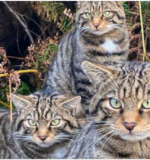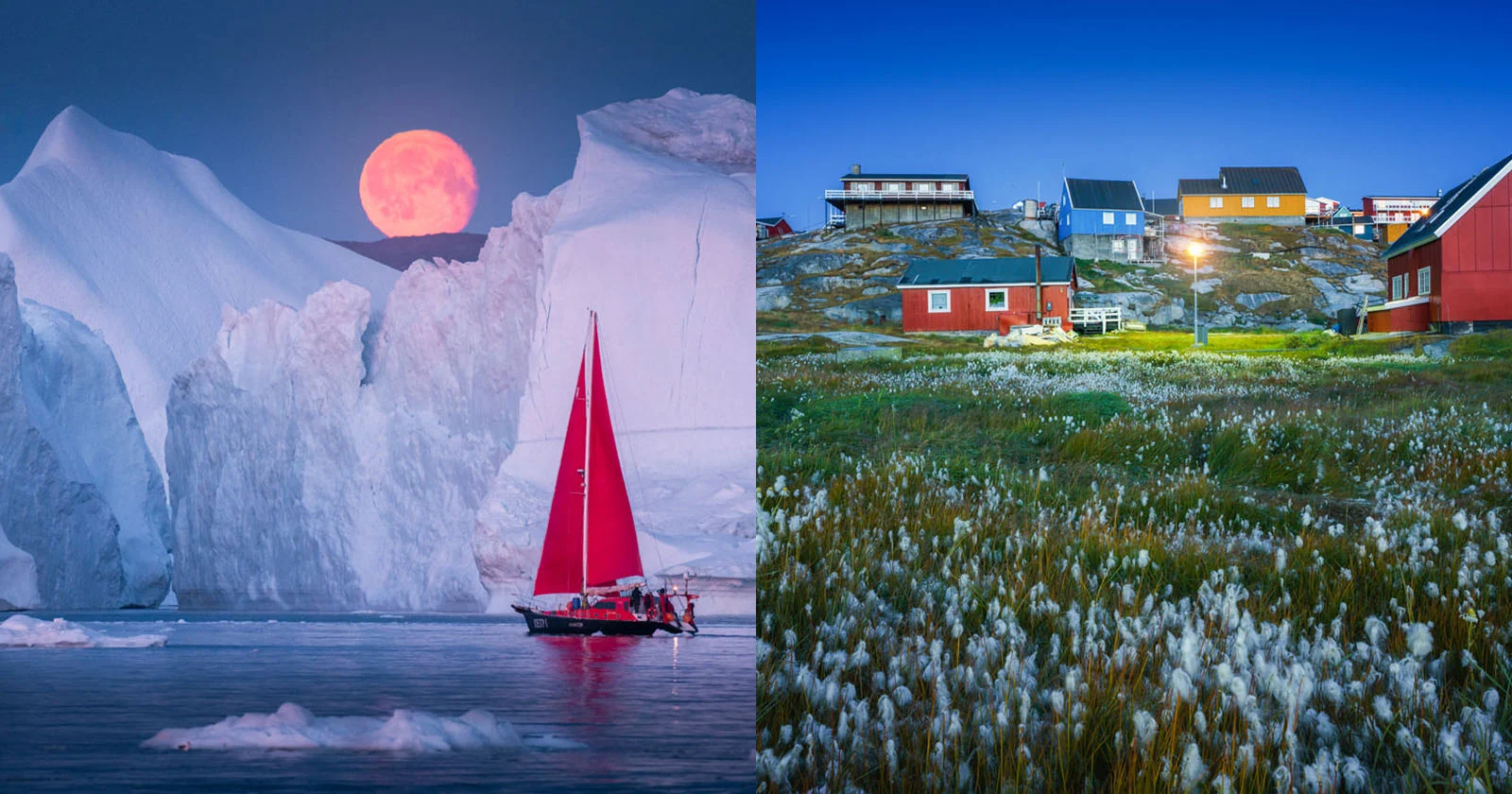After 2000 years of isolation, a few decades of interbreeding have rendered the animal “genomically extinct”
Though it lies in ruins on the northeast coast of England, Kilton Castle was once an imposing stone fortress, home to several noble families, and—it appears—at least eight cats. Archaeological excavations in the 1960s uncovered a well, at the bottom of which lay the bones of several felines dating back to the 14th century. The animals were an odd mix: Some were domestic cats, but other, larger specimens appeared to be European wildcats, a fierce, burly species that has inhabited the continent for hundreds of thousands of years.
 This trio of captive Scottish wildcats is part of the Royal Zoological Society’s Saving Wildcats Project.SAVING WILDCATS
This trio of captive Scottish wildcats is part of the Royal Zoological Society’s Saving Wildcats Project.SAVING WILDCATS
The two species’ closeness in death was deceptive. A study published today in Current Biology finds that even though European wildcats and domestic cats overlapped in Great Britain for more than 2000 years—including at sites such as Kilton—they appear to have almost never interbred. That changed suddenly about 70 years ago, when domestic cats began to mate with wildcats in Scotland. In the span of mere decades, the genome of the Scottish wildcat—the last remaining wildcat in Great Britain—has become so corrupted that the animal is now effectively extinct, a second study in the same issue finds. The findings could complicate ongoing efforts to save the most endangered mammalian carnivore in Great Britain.
“It’s very intriguing work,” says Shu-Jin Luo, a geneticist at Peking University who researches the DNA of wildcats in China and who has similar concerns about the impact of domestic cats there. “The studies set a very good template for studying the interactions between domestic cats and wildcats around the world.”
Domestic cats have been in Europe for thousands of years, having likely followed migrating farmers from their birthplace in the Middle East. Once they entered the continent, they invaded the home of a distant relative, the European wildcat.
The two aren’t so different: Both belong to the genus Felis (our kitties are F. catus; the wildcat is F. silvestris), and the European wildcat has a brown, striped coat reminiscent of some tabbies. But the wildcat is about 20% bigger, with denser fur and a thick, blunt tail. It’s also fiercely solitary and wants nothing to do with humans. Try as you might to tame it, says Roo Campbell, a mammal specialist at NatureScot, Scotland’s nature agency, “you’re not going to end up with a cuddly pet.”
So perhaps it’s no surprise that domestic cats and European wildcats kept to themselves. Even though domestic cats became widespread in Europe during Roman times, DNA markers from modern cats and ancient bones show virtually no genetic overlap between the two species, the first paper reports.
One explanation is that—Kilton Castle aside—they largely avoided the same places. Domestic cats lived in close proximity to people, where food (and perhaps petting) was plentiful, whereas wildcats preferred scrubland far from human habitation. Wildcats also only mate twice a year, whereas domestic cats can mate whenever they want, so hooking up at the right time would have proved challenging.
Dogs and wolves show a similar pattern, notes study author Greger Larson, an evolutionary biologist at the University of Oxford. Those two canids have overlapped in the Northern Hemisphere for at least 11,000 years, he says, but show little evidence of interbreeding.

Yet the barrier between domestic cat and wildcat eventually broke down. The second new study—based on DNA from dozens of modern domestic cats and wildcat samples from nature, captivity, and museums—finds that, starting in the mid-1950s, more than 5% of the genetic markers in Scottish wildcats began to resemble those of domestic cats. After 1997, that figure jumped to as high as 74%.
That may be because the Scottish wildcat had nowhere else to go, says Campbell, an author of the study. Human hunting of wildcats—for pelts and because they were seen as vermin—in Great Britain in medieval times eventually drove the animals up into the remote highlands of Scotland. “It was their last stronghold,” he says. Here, they began to recover. But in the 1950s, a viral disease decimated the rabbits the cats relied on, while human encroachment stole critical habitat. As their population shrunk—by some estimates it became as low as 30 individuals—they had no choice but to mate with domestic cats.
Today, the genome of the Scottish wildcat is so “swamped” with domestic cat DNA that the animal is “genomically extinct,” the authors conclude. All that’s left in nature is a “hybrid swarm,” they write, a confused mix of wild and domestic DNA. In some cases, the wildcats’ striking stripes have been replaced by spots, as well as other patterns and colors not found in nature.
“Everything these wildcats have evolved over thousands of years is being lost in a few generations,” says the study’s lead author, Jo Howard-McCombe, a conservation geneticist at the Royal Zoological Society of Scotland (RZSS). The findings are a particular sting to Scotland, where the wildcat is a symbol of bravery and independence, appearing on everything from high school logos to the crests of storied clans.
Ironically, the one thing that may have kept Scottish wildcats hanging on so long is genes they inherited from domestic cats. The researchers found that wildcat DNA was heavily enriched in domestic “major histocompatibility complex” genes, which help our pets fight deadly diseases such as feline leukemia and feline immunodeficiency virus (similar to AIDS in humans). But the only reason wildcats would have been exposed to these diseases in the first place is close contact with domestic cats, Howard-McCombe says. “It’s like they’re stabbing you, then calling the ambulance.”
Some hope may lie in the 160 Scottish wildcats that live in captivity, thanks to early conservation efforts. Only 18% of their DNA markers register as domestic, according to the new work. Helen Senn, an author on both new papers and the leader of RZSS’s Saving Wildcats Project, is spearheading an effort to reintroduce the captive cats back into the wild. This summer, her team released 19 of the animals into a national park in the Scottish highlands, far from domestic cats. The team hopes that as the wildcats adapt to their environment over several generations, they’ll begin to shed their domestic DNA.
The plan sounds dubious to Steve Piper, former chairman of the Scottish Wildcat Association, a conservation charity. He believes the captive wildcats are genetically too far gone to rescue. A better solution, he says, would be to introduce wildcats from Romania or elsewhere in Europe, where they’re still thriving.
Senn remains optimistic, however. She knows that it may never be possible to return to the Scottish wildcat to 100% of its genetic glory. But, she says, “We’ve got to start somewhere.”
Source: News from Science








 Photographer Finds Locations Of 1960s Postcards To See How They Look Today, And The Difference Is Unbelievable
Photographer Finds Locations Of 1960s Postcards To See How They Look Today, And The Difference Is Unbelievable  Hij zet 3 IKEA kastjes tegen elkaar aan en maakt dit voor zijn vrouw…Wat een gaaf resultaat!!
Hij zet 3 IKEA kastjes tegen elkaar aan en maakt dit voor zijn vrouw…Wat een gaaf resultaat!!  Scientists Discover 512-Year-Old Shark, Which Would Be The Oldest Living Vertebrate On The Planet
Scientists Discover 512-Year-Old Shark, Which Would Be The Oldest Living Vertebrate On The Planet  Hus til salg er kun 22 kvadratmeter – men vent til du ser det indvendigt
Hus til salg er kun 22 kvadratmeter – men vent til du ser det indvendigt  Superknepet – så blir snuskiga ugnsformen som ny igen!
Superknepet – så blir snuskiga ugnsformen som ny igen!  Meteorite That Recently Fell in Somalia Turns Out to Contain Two Minerals Never Before Seen on Earth
Meteorite That Recently Fell in Somalia Turns Out to Contain Two Minerals Never Before Seen on Earth  Nearly Frozen Waves Captured On Camera By Nantucket Photographer
Nearly Frozen Waves Captured On Camera By Nantucket Photographer  It’s Official: Astronomers Have Discovered another Earth
It’s Official: Astronomers Have Discovered another Earth 
zq618o
4o1loz
g2mcup
7fomx1
v7xzli